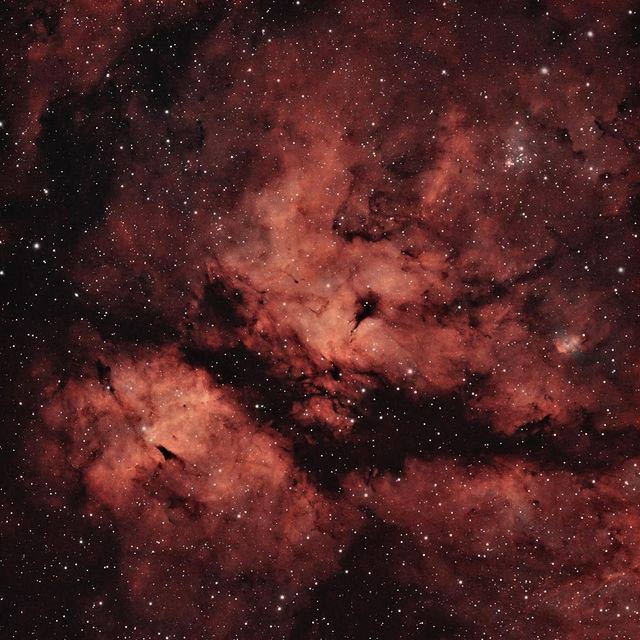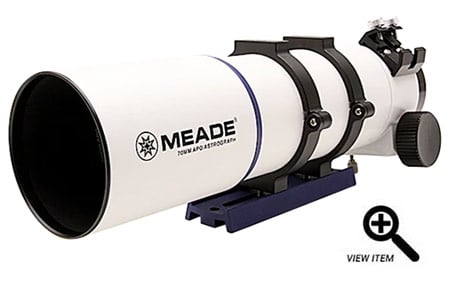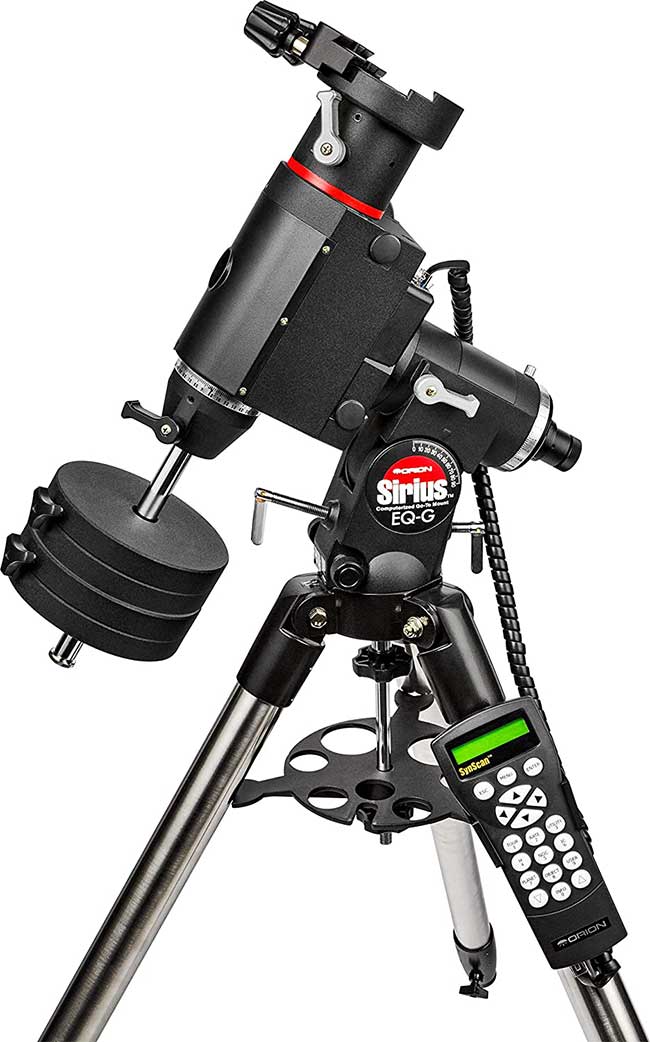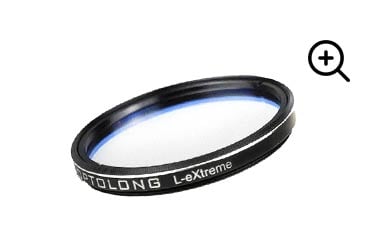Backyard of the Week | May 17, 2021
The AstroBackyard ‘Backyard of the Week’ highlights astrophotography setups from around the world. We break down each piece of the system so you can understand exactly what goes into a successful imaging kit.
This week’s backyard astrophotography equipment profile comes to us from Nicholas Bradley from Michigan, USA. Yes, that’s two Michigan backyards in a row!
Location: Michigan, USA
Nicholas uses a compact, quadruplet apochromatic refractor telescope to photograph the deep space objects from home. I had a chance to test out the Meade 6000 Series 70mm APO in 2017, and it was an absolute joy to use on large nebulae projects with my DSLR camera.
You’ll notice the riser blocks underneath the telescope rings to raise the height of the telescope from the dovetail mount. This is a great solution to achieve balance on this telescope without having the focuser run into the declination mount.
The Orion Sirius EQ-G is a widely used and enjoyed equatorial telescope mount, and is nearly exactly the same as the Sky-Watcher HEQ5 Pro.
ZWO ASI cameras are used for both imaging and autoguiding, and a Pegasus Astro Pocket Powerbox Advance delivers power to the primary imaging camera and dew heater bands.
Nicholas Bradley
Nick is a 19-year old amateur astrophotographer with a bright future ahead of him. His backyard is a Bortle Scale Class 7, but it does not seem to be holding him back whatsoever.
I urge you to check out his impressive Instagram gallery for an idea of what he’s up to, and the evolution of his equipment.
As you can see from the photo below, Nicholas has this setup running like a top. The Sadr region is one of the most dynamic regions of hydrogen gas in the night sky to photograph.
This framing highlights the stunning Butterfly Nebula (IC 1318), the most intense region of hydrogen emission activity in the area.
Heart of Cygnus by Nicholas Bradley using his Meade 70mm Astrograph
Nicholas’s Astrophotography Equipment
| Primary Imaging Camera | ZWO ASI533MC Pro |
| Telescope | Meade Series 6000 70mm F/5 Astrograph |
| Telescope Mount | Orion Sirius EQ-G |
| Filters | Optolong L-Pro + Optolong L-eXtreme |
| Guide Scope | Orion 50mm mini Guide Scope |
| Guide Camera | ZWO ASI120MC Super Speed |
| Dew Control | Pegasus Powerbox Advance |
| Camera Control Software | N.I.N.A |
What Nicholas loves most about his setup?
“Get data decently fast, guiding doesn’t have to be amazing for sharp stars! Focusing is a breeze with the Meade 70mm Quadruplet. My setup can be set up very quickly for spontaneous unplanned imaging sessions.
No field flattener needed and great color correction from the Meade.”
The compact refractor experience is tough to beat. Setting up a 5-pound telescope for a night of imaging is absolutely painless, and often leads to more imaging sessions overall.
The Cygnus Wall by Nicholas Bradley
Nicholas used the Optolong L-eXtreme filter to capture this impactful image of the Cygnus Wall in under 2 hours. Clearly, the ZWO ASI533MC Pro and the L-eXtreme are a great match.
The Camera
The ZWO ASI533MC Pro is an affordable one-shot-color camera capable of collecting sharp, detailed images of nebulae and galaxies. I love the pixel size of this camera (3.76 um), which creates the same desirable resolution found on more robust color cameras like the QHY268C.
This camera features a Sony IMX533 1-inch square sensor, with a resolution of 3008 x 3008 pixels. At a focal length of 350mm on the Meade Astrograph, the image scale calculates to a sharp, 2.2 arc-seconds per pixel.
The Telescope
The Meade Series 6000 70mm F/5 Astrograph is a compact, quadruplet apochromatic refractor offering a well-corrected, flat field without the need for a corrector/flattener.
The optics of this telescope are about as good as it gets, which is why this particular scope is highly sought after by amateur astrophotographers looking for a wide-field imaging APO.
Meade Series 6000 70mm F/5 Astrograph
Meade Series 6000 70mm F/5
- Type: Astrograph
- Diameter: 70mm
- Focal Length: 350mm
- Focal Ratio: F/5
- Focuser: 2.5″ dual-speed Rack and Pinion
- Weight: 2.04 kg (4.5 lbs)
The Mount
The Orion Sirius EQ-G has been a reliable choice for many years in the hobby. Borrowing the same internal components as the Sky-Watcher HEQ5, this intermediate-level astrophotography mount was built to last.
Orion Sirius EQ-G
Filters
It’s difficult to imagine 2 filters that are more useful for a one-shot-color camera than these. The L-Pro is great for broadband targets like reflection nebulae and galaxies, while the L-eXtreme is best for nebulae targets.
Both of these filters are extremely useful from a light-polluted location in the city, and I am not surprised to see Nick enjoying these two particular filters from his Bortle Class 7 sky.
Optolong L-eXtreme Duo-Bandpass Filter.
Guide Camera
The ZWO ASI120MC-S is a popular choice for those looking to add autoguiding to their system. The camera uses a 1.2 MP CMOS sensor to find suitable stars in your guide scope to make subtle improvements to your telescope’s tracking accuracy.
This affordable one-shot-color camera has a resolution of 1280 x 960 pixels, making it a capable planetary imaging camera as well.
ZWO ASI120MC Super Speed
Camera Control Software
Nick uses N.I.N.A (Nighttime Imaging N’ Astronomy) to control his camera and automate the imaging session. This software allows him to choose, frame, and focus his deep-space targets using a variety of useful tools.
This is a worthy software choice to consider if Astro Photography Tool or Sequence Generator Pro aren’t your cup of tea.
Thank you for sharing your backyard astrophotography set up with us, Nicholas! View Nicholas’s astrophotography gallery on Astrobin or check out his work on Instagram.
Be sure to fill out the form to submit your backyard for a chance to be featured, and don’t forget to include your Instagram handle to help grow your following.








